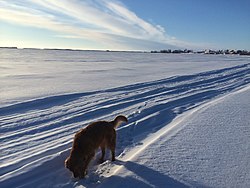Top Qs
Timeline
Chat
Perspective
Whatì
First Nation in Northwest Territories, Canada From Wikipedia, the free encyclopedia
Remove ads
Whatì (/ˈhwɒti/;[6] from the Dogrib language meaning "Marten Lakes"), officially the Tłı̨chǫ Community Government of Whatì[7] is a First Nations community in the North Slave Region of the Northwest Territories, Canada. Whatì is located by Lac La Martre, about 164 km (102 mi) northwest of the territorial capital of Yellowknife.
Remove ads
History
Summarize
Perspective
With rich and varied wildlife, the area has long been a favoured hunting ground of the Tłı̨chǫ (Dogrib Dene) Indigenous people. The North West Company established a trading post there in 1793, and many natives began settling there permanently, while they continued to hunt and fish in the area. With the establishment of a trading post at Fort Rae on Great Slave Lake in the late 19th century, most regional trading was accomplished at the Hudson's Bay Company and free traders posts there. A trading post at Lac La Martre was not again established until the 1920s.[8]
On January 1, 1996, the community officially changed its name from Lac La Martre to the Tłı̨chǫ name "Wha Ti", meaning "Marten Lake," the same meaning as the French and then on August 4, 2005[3] to the current spelling. Other traditional Tłı̨chǫ names for the settlement include Tsoti[pronunciation?] ('fouled water lake') and Mine Go Kola[pronunciation?] ('net fishing with houses').[3]
Before 2005, the community was unincorporated, and local governance was provided by a First Nations band government, Wha Ti First Nation. Under the terms of the Tłı̨chǫ Agreement, most responsibilities of Wha Ti have been transferred to a new Whatì Community Government. However, the First Nation is still recognized by the federal government for Indian Act enrollment.
Remove ads
Demographics
In the 2021 Census of Population conducted by Statistics Canada, Whatì had a population of 543 living in 143 of its 162 total private dwellings, a change of 15.5% from its 2016 population of 470. With a land area of 58.33 km2 (22.52 sq mi), it had a population density of 9.3/km2 (24.1/sq mi) in 2021.[16]
The majority of the population is Indigenous of which 445 were First Nations and 10 were Métis. The main languages were Dogrib and English with a few North Slavey speakers.[1]
Remove ads
Economy
While trapping, hunting, and fishing continue to be the main economic activities in this traditional community, efforts have been made to develop tourism as well. A fishing lodge was opened, and many tourists come to see the abundant wildlife, including black bears, barren-ground caribou, wolves, and eagles. The community takes special pride in the fact that no alcohol is allowed there.
Whatì is part of the Tlicho Government.[18]
Infrastructure
Transport
Whatì Airport connects the community by air to the territorial capital Yellowknife.
Whatì is connected to the territorial road network by the Tłı̨chǫ Highway (Northwest Territories Highway 9), an all-season gravel road running from the community to the Yellowknife Highway (Northwest Territories Highway 3). The only road access to Whatì prior to the Tłı̨chǫ Highway opening in 2021 was via winter road.[19][20]
Communications
Telephone service was introduced to Whati in 1982.
Remove ads
Climate
Summarize
Perspective
Whatì has a subarctic climate (Köppen: Dfc; Trewartha: Ecld) with mild to warm summers and long cold winters.
Remove ads
See also
References
External links
Wikiwand - on
Seamless Wikipedia browsing. On steroids.
Remove ads



